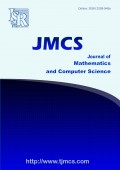The Gopala-Hemachandra universal code determined by straight lines
Volume 19, Issue 3, pp 158--170
http://dx.doi.org/10.22436/jmcs.019.03.03
Publication Date: May 17, 2019
Submission Date: November 23, 2018
Revision Date: February 22, 2019
Accteptance Date: April 19, 2019
-
1982
Downloads
-
4043
Views
Authors
Joydeb Pal
- Department of Mathematics, National Institute of Technology Durgapur, Burdwan, W.B., Pin-713209, India.
Monojit Das
- Shibpur Dinobundhoo Institution (College), Howrah, W.B., Pin-711102, India.
Abstract
Variation on the Fibonacci universal code, known as Gopala-Hemachandra (or GH) code, is mainly used in data compression and cryptography as it is a self-synchronizing code. In 2010, Basu and Prasad showed that Gopala-Hemachandra code \(GH_a(n)\) exists for \(-20 \leq a \leq -2\) and \(1 \leq n \leq 100\) as well as there are \(m\) consecutive non-existing Gopala-Hemachandra codewords in \(GH_{-(4+m)}(n)\) column where \(1 \leq m \leq 16\). In this paper, we have introduced GH code straight line in two-dimensional space where each integral point \((a, n)\) on the GH code straight line represents a unique GH codeword. GH code straight lines confirm the existence of GH codewords for any integer \(n \geq 1\) and integer \(a \leq -2\). Moreover, for a given parameter \((a, n)\), we have introduced two methods to check whether GH codeword exists or not.
Share and Cite
ISRP Style
Joydeb Pal, Monojit Das, The Gopala-Hemachandra universal code determined by straight lines, Journal of Mathematics and Computer Science, 19 (2019), no. 3, 158--170
AMA Style
Pal Joydeb, Das Monojit, The Gopala-Hemachandra universal code determined by straight lines. J Math Comput SCI-JM. (2019); 19(3):158--170
Chicago/Turabian Style
Pal, Joydeb, Das, Monojit. "The Gopala-Hemachandra universal code determined by straight lines." Journal of Mathematics and Computer Science, 19, no. 3 (2019): 158--170
Keywords
- Fibonacci numbers
- Fibonacci coding
- Gopala-Hemachandra sequence
- Gopala-Hemachandra code
- Zeckendorf's representation
MSC
References
-
[1]
M. Basu, B. Prasad, Long range variations on the Fibonacci universal code, J. Number Theory, 130 (2010), 1925--1931
-
[2]
D. E. Daykin, Representation of natural numbers as sums of generalized Fibonacci numbers, J. Lond. Math. Soc., 35 (1960), 143--160
-
[3]
P. Elias, Universal codeword sets and representations of the integers, IEEE Trans. Information Theory, 21 (1975), 194--203
-
[4]
S. Kak, A ristotle and Gautama on logic and physics, arXiv, 2005 (2005), 16 pages
-
[5]
S. Kak, Greek and Indian cosmology: Review of early history, arXiv, 2005 (2005), 38 pages
-
[6]
D. Knuth, Negafibonacci Numbers and the Hyperbolic Plane, Paper presented at the annual meeting of the Mathematical Association of America, San Jose (2008)
-
[7]
I. G. Pearce, Indian mathematics: Redressing the balance, University of St. Andrews, U. K. (2002)
-
[8]
J. H. Thomas, Variation on the Fibonacci universal code, arXiv, 2007 (2007), 4 pages
-
[9]
E. Zeckendorf, Representation des nombres naturels par une somme des nombres de Fibonacci ou de nombres de Lucas (French), Bull. Soc. Roy. Sci. Liege, 41 (1972), 179--182

